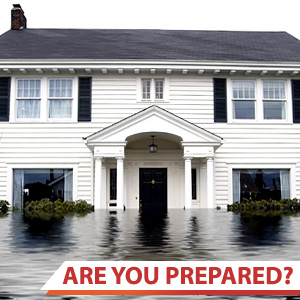Flooding

Floods are a common and widespread natural hazard across Canada, causing extensive damage to property and loss of life. Floods can result from heavy rainfall, sewer backups, severe storms, breaking dams, broken water mains, and thawing of snow and ice. Some floods develop slowly, sometimes over a period of days or weeks. However, flash flooding usually occurs with little or no advance warning.
It is important to be aware of flood hazards no matter where you live. Keep up to date by listening to radio or television for the latest information related to flooding or potential flooding in your community.
How to prepare…Before, During and After a Flood
Before a Flood
- Have a 72 hour emergency kit and make a family emergency plan.
- Ensure downspouts drain a sufficient distance from your home to allow water to flow away.
- Install weather protection sealant around basement windows and the base of ground-level doors.
- Consider installing a sump pump and zero reverse flow valves in basement floor drains.
- Do not store your important documents in the basement. Store your personal items (e.g., photo albums) in durable leak proof containers.
- Check your insurance policy for flood coverage.
During a Flood
- Listen to your local news stations to find out what areas are affected, what roads are safe, and what to do if have to leave your home
- Keep your 72 hour emergency kit ready, in a portable container or suitcase
- Ensure that the power and gas has been turned off in your home
- Remain on the upper floor of your home to wait for help from local authorities
- Leave a note for family, friends and rescuers to know where you are, if you have left your home
- Avoid driving through flooded areas as they may be deeper than they appear, take an alternate route or travel by foot.
- Stay on higher ground and avoid entering flood waters as you may be swept away or harmed by the contents of the water (sewage, chemicals, sharp objects etc.).
- To avoid physical injuries during a flood, keep children and pets out of the affected area. Do not swim in the flood water. Flood water can conceal sharp objects that could cause injuries
After a Flood
Personal Safety
- Do not return home until you have been advised by the authorities that is it safe
- If you smell gas after entering the home, leave immediately and contact your gas provider as well as the fire department
- To reduce the risk of fire or electrical shock, ensure that the electrical panel, all outlets, and appliances that have been affected are cleaned, dried out and inspected by a qualified electrician.
- Ensure that all wood, gas or electrical heating systems are inspected by a qualified technician prior to use.
Clean up
- Contact your insurance company before you start the clean-up process. Record all details of the flood damage to your property through photos and video.
- If your home has had severe water damage or has been flooded with sewage, you will need to hire a professional contractor.
- When entering a flooded area in your home and handling any contaminated materials, ensure that protective equipment such as rubber boots, protective eye wear, rubber gloves and a face mask is worn.
- Provide adequate ventilation to the home by opening windows and through the use of fans.
- Pump out all remaining flood water from the home once the outside water levels begin to recede, use a submersible pump and a wet dry vacuum.
- Dispose household items that have been exposed to floodwater and cannot be dried within 48 hours. Clean and disinfect items that will be kept.
- Discard flooring, insulation materials, and drywall (up to 30 cm above water line) soaked by floodwater
- Dispose food items that have been exposed to flood waters (boxed foods, foods stored in refrigeration and freezer units, fresh fruits as well as home preserves and bottled drinks). All undamaged canned goods can be washed and disinfected.
- Use fans, heaters and dehumidifiers as needed to speed up the drying process to prevent mould growth.
- Clean walls, floors and surfaces with hot water and soap first, then disinfect using a bleach solution. To prepare bleach solution - Mix two cups (0.5L) of unscented household bleach (5.25%) with 18 cups (4.5L) of clean water.
Water Supply
It is possible that drinking water could become contaminated during a flood. Follow the advice of your municipality and Health Unit regarding the safety of the water supply. If there is any possibility that the water supply is unsafe, you will be advised to boil water prior to drinking.

